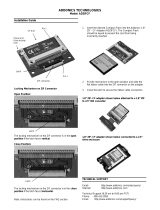Dell Latitude X300: With its compact size and sturdy build, the Latitude X300 is the ideal laptop for professionals on the go. Its long battery life and optional extended battery ensure uninterrupted productivity, while the variety of ports and expansion slots provide seamless connectivity and versatility. Whether you're in the office, at home, or traveling, the Latitude X300 is the perfect companion for all your computing needs.
Dell Latitude X300: With its compact size and sturdy build, the Latitude X300 is the ideal laptop for professionals on the go. Its long battery life and optional extended battery ensure uninterrupted productivity, while the variety of ports and expansion slots provide seamless connectivity and versatility. Whether you're in the office, at home, or traveling, the Latitude X300 is the perfect companion for all your computing needs.
















-
 1
1
-
 2
2
-
 3
3
-
 4
4
-
 5
5
-
 6
6
-
 7
7
-
 8
8
-
 9
9
-
 10
10
-
 11
11
-
 12
12
-
 13
13
-
 14
14
-
 15
15
-
 16
16
-
 17
17
-
 18
18
-
 19
19
-
 20
20
-
 21
21
-
 22
22
-
 23
23
-
 24
24
-
 25
25
-
 26
26
-
 27
27
-
 28
28
-
 29
29
-
 30
30
-
 31
31
-
 32
32
-
 33
33
-
 34
34
-
 35
35
-
 36
36
-
 37
37
-
 38
38
-
 39
39
-
 40
40
-
 41
41
-
 42
42
-
 43
43
-
 44
44
-
 45
45
-
 46
46
-
 47
47
-
 48
48
-
 49
49
-
 50
50
Dell Latitude X300: With its compact size and sturdy build, the Latitude X300 is the ideal laptop for professionals on the go. Its long battery life and optional extended battery ensure uninterrupted productivity, while the variety of ports and expansion slots provide seamless connectivity and versatility. Whether you're in the office, at home, or traveling, the Latitude X300 is the perfect companion for all your computing needs.
Ask a question and I''ll find the answer in the document
Finding information in a document is now easier with AI
Related papers
-
Dell Latitude X300 User manual
-
Dell Inspiron 5150 Quick start guide
-
Dell Inspiron 630m User manual
-
Dell Inspiron 300m User manual
-
Dell Inspiron X200 Owner's manual
-
Dell PP07S Owner's manual
-
Dell Inspiron 700m User manual
-
Dell precision m2400 User manual
-
Dell Latitude PP27L User manual
-
Dell E6500 User manual
























































